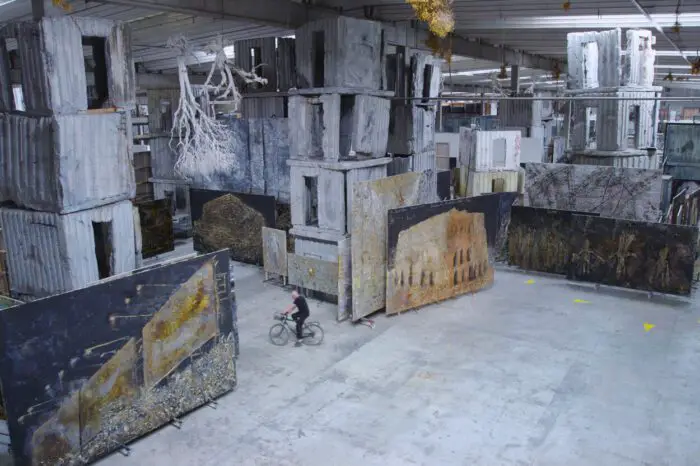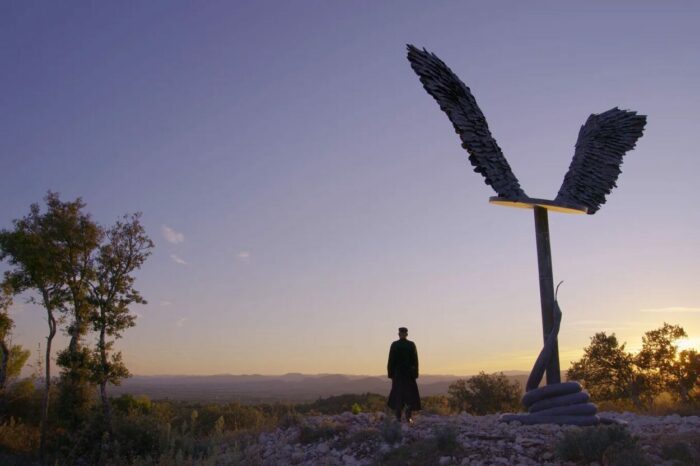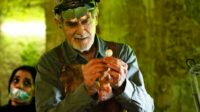Anselm aspires to immerse viewers in the perspective of German artist Anselm Kiefer. This documentary is a surreal journey exploring the works of this painter and sculptor. Yet, it remains grounded despite a dream-like stylization, anchored to reality by the horrors which inspired Kiefer’s work. What manifests is the chronicle of a career that has stirred controversy by asking hard questions about matters many would rather remain unspoken.
Conceived by director Wim Wenders, Anselm provides an outline of the titular artist’s life. Focusing mainly on his paintings, sculptures, and later installations, the documentary gives an overview that is surprisingly intimate in its brevity. At times the film simply observes in silence, and one could argue the movie presents the idea an artist is the art, so understanding one gives a glimpse inside the other. At the same time, there is such an overwhelming sense of artifice, a conscious awareness of presentation that the opposite seems true as well. In other words, it’s safe to wonder if the film is being completely honest, or perhaps trying to imply truth through artificial moments. Thankfully, such questions are left for the audience to answer as they see fit.

The result is like floating through a fantastical macabre reality. Dresses stand empty and alone with barbed wire boiling up in place of heads. Painted landscapes reveal murky, war-scarred vistas. Staticky televisions replay interviews from decades back. Petrified airplanes dot the grounds of Kiefer’s 200-acre artistic installation, where all his works now reside. This surreal world all his own can’t help calling to mind Goya crafting the fourteen Black Paintings at the Quinta del Sordo. Both artists having created captivating bleak testaments to inhumanity.
Anselm Kiefer rose to prominence in the late 1960s. His art mainly grabbed attention because it asked tough questions of his native Germany. At the time, still wrestling with their role in World War II, the German people didn’t care for reminders of the very recent dark past. Anselm Kiefer, however, felt it necessary to interrogate that silence, asking why it existed by presenting works tied to that unspoken nightmare. In essence, exploring the past to find lessons for tomorrow as well as ways to heal historical scars.
The results are hauntingly grim works. Anselm succeeds by never really spoon-feeding much understanding. The audience gradually gleans what these artistic expressions are, where they come from, and what they might mean. For instance—spoiler warning—Anselm Kiefer is shown working on massive pieces decorated with burnt straw. This is a continuation of a visual trope he’s employed since the 1980s regarding Margarete and Shulamite, two figures who serve as a central metaphor in poet Paul Celan’s famous “Todesfuge”. At one point the poem is read in its entirety, and talk of the Holocaust increases the implicative nature of Anselm’s art.

Reenactments from moments in Kiefer’s life help provide biographical information, but nothing ever occurs that seems like a stylized recitation of a Wikipedia page. Rather, it feels like an artistic reimagining of events. Bits of old television interviews splice in other background info. However, a great deal tends to come from Anselm himself.
The problem then becomes that the whole documentary feels a bit one-sided. Although the film mentions negative reactions to his work, there is no exploration of that perspective. The whole goal here is to investigate Anselm’s point of view and to some extent his creative process. Consequently, when discussing hostility towards his art, Anselm dismisses it with the weariness of someone sick of answering a question, who refuses to elaborate, and instead of finding ways to expound for him, the documentary remains silent.
Similar silence abounds about his personal life. The whole documentary seems determined to state he was born, he did art, and the remains of his surreal world in Barjac, France will be his legacy—end of story. That’s fine, though it leaves a gaping hole in the narrative. After all, one imagines friends and family must have made some contribution, however indirect, on this creative process. The consequence is a portrait of the man that feels intentionally incomplete.
Anselm is showing Oct. 19, 2023 at the Logan Center for the Arts as an official selection of the Chicago International Film Festival.
Wim Wenders is the director of the award-winning film Paris, Texas (1984) as well as Academy Award nominated documentaries such as Buena Vista Social Club (1999) and The Salt of the Earth (2014). He is also known for The Road Trilogy, three films from the mid-1970s “unified by shared themes, an exacting formal rigor, and the presence of Rüdiger Vogler.” Not to mention the docudrama A Trick of the Light (1995) starring Udo Kier about brothers Emil and Max Skladanowsky, who pioneered early film techniques and technology. Also known as Die Gebrüder Skladanowsky, it’s a combination of fictionalized reenactments and experimental photography exploring the dawn of cinema.
The point being Wim Wenders is no stranger to capturing artistic expression in ways meant to engage an audience. The way art is conceived and its influence, or at least intended influence, on society seems to be a recurrent theme. Buena Vista Social Club explored Cuban music, and The Salt of the Earth served as a biographical look at Brazilian photographer Sebastião Salgado. With Anselm, such themes continue.
The whole documentary is shot in 3D. Something Wenders already utilized on the documentary Pina (2011). Unfortunately, it does nothing to enhance the viewing experience here. Frankly, 3D is an unnecessary gimmick. Wenders cinematic stylizations captivate enough on their own.
Anselm is a journey into darkness. Director Wim Wenders brings viewers into a surreal reality conceived by an extraordinary artist. Although the documentary can feel slanted and a certain artifice in the presentation can seem more like fictionalization than stylization, the goal here — presenting the perspective of Anselm Keifer — hits the mark. Audiences will be entranced by the visual aspect, and if they align with the ideas Kiefer explores, discover a haunting look at history.
Anselm already premiered at Cannes, is showing at the Chicago Film Festival October 19th, and opens in select theaters December 8th.


